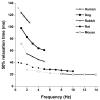Determinants of frequency-dependent contraction and relaxation of mammalian myocardium
- PMID: 17919652
- PMCID: PMC2093987
- DOI: 10.1016/j.yjmcc.2007.08.012
Determinants of frequency-dependent contraction and relaxation of mammalian myocardium
Abstract
An increase in heart rate is the primary mechanism that up-regulates cardiac output during conditions such as exercise and stress. When the heart rate increases, cardiac output increases due to (1) an increased number of beats per time period, and (2) the fact that myocardium generates a higher level of force. In this review, we focus on the underlying mechanisms that are at the basis of frequency-dependent activation of the heart. In addition to increased force development, the kinetics of both cardiac activation and relaxation are faster. This is crucial, as in between successive beats there is less time, and cardiac output can only be maintained if the ventricle can fill adequately. We will discuss the cellular mechanisms that are involved in the regulation of rate-dependent changes in kinetics, with a focus on changes that occur in regulation of the intracellular calcium transient, and the changes in the myofilament responsiveness that occur when the heart rate changes.
Figures


References
-
- Bowditch HP. Ueber die Eigenthuemlichkeiten der Reizbarkeit, welche die Muskelfasern des Herzens zeigen. Ber Sachs Ges (Akad) Wiss. 1871;23:652–89.
-
- Layland J, Kentish JC. Positive force- and [Ca2+]i-frequency relationships in rat ventricular trabeculae at physiological frequencies. Am J Physiol Heart Circ Physiol. 1999;276(1 Pt 2):H9–H18. - PubMed
-
- Meyer M, Bluhm WF, He H, Post SR, Giordano FJ, Lew WY, et al. Phospholamban-to-SERCA2 ratio controls the force-frequency relationship. Am J Physiol. 1999;276(3 Pt 2):H779–85. - PubMed
-
- Pieske B, Kretschmann B, Meyer M, Holubarsch C, Weirich J, Posival H, et al. Alterations in intracellular calcium handling associated with the inverse force-frequency relation in human dilated cardiomyopathy. Circulation. 1995;92(5):1169–78. - PubMed
Publication types
MeSH terms
Substances
Grants and funding
LinkOut - more resources
Full Text Sources
Other Literature Sources

